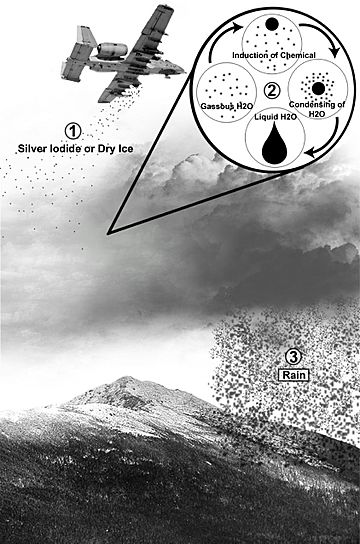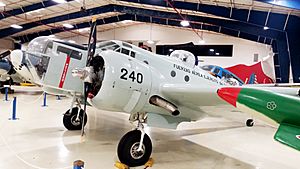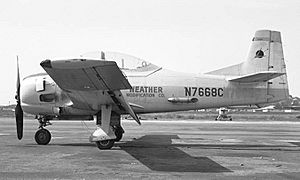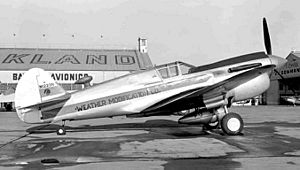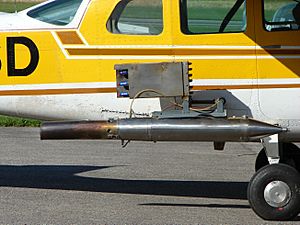Cloud seeding facts for kids
Cloud seeding is a type of weather modification that aims to change the amount or type of precipitation that falls from clouds by dispersing substances into the air that serve as cloud condensation or ice nuclei, which alter the microphysical processes within the cloud. Its effectiveness is debated; some studies have suggested that it is "difficult to show clearly that cloud seeding has a very large effect." The usual objective is to increase precipitation (rain or snow), either for its own sake or to prevent precipitation from occurring in days afterward.
Contents
Methodologies
Salts
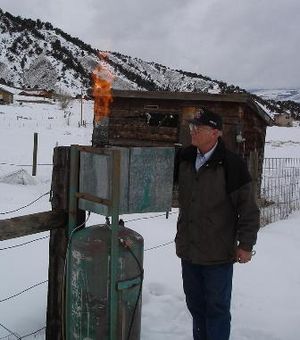
The most common chemicals used for cloud seeding include silver iodide, potassium iodide and dry ice (solid carbon dioxide). Liquid propane, which expands into a gas, has also been used. This can produce ice crystals at higher temperatures than silver iodide. After promising research, the use of hygroscopic materials, such as table salt, is becoming more popular.
When cloud seeding, increased snowfall takes place when temperatures within the clouds are between −20 and −7 °C. Freezing nucleation is induced by the introduction of substances similar to silver iodide, which has a crystalline structure like ice.
In mid-altitude clouds, the usual seeding strategy has been based on the fact that the equilibrium vapor pressure is lower over ice than over water. The formation of ice particles in supercooled clouds allows those particles to grow at the expense of liquid droplets. If sufficient growth takes place, the particles become heavy enough to fall as precipitation from clouds that otherwise would produce no precipitation. This process is known as "static" seeding.
Seeding of warm-season or tropical cumulonimbus (convective) clouds seeks to exploit the latent heat released by freezing. This strategy of "dynamic" seeding assumes that the additional latent heat adds buoyancy, strengthens updrafts, ensures more low-level convergence, and ultimately causes rapid growth of properly selected clouds.
Cloud seeding chemicals may be dispersed by aircraft or by dispersion devices located on the ground (generators or canisters fired from anti-aircraft guns or rockets). For release by aircraft, silver iodide flares are ignited and dispersed as an aircraft flies through the inflow of a cloud. When released by devices on the ground, the fine particles are carried downwind and upward by air currents after release.
Electric charges
Since 2021, the United Arab Emirates has been using a new technology: drones equipped with a payload of electric-charge emission instruments and customised sensors fly at low altitudes and deliver an electric charge to air molecules. This method produced a significant rainstorm in July 2021. For instance, in Al Ain it rained 6.9 millimetres on 20–21 July.
Infrared laser pulses
An electronic mechanism was tested in 2010, when infrared laser pulses were directed to the air above Berlin by researchers from the University of Geneva. The experimenters posited that the pulses would encourage atmospheric sulfur dioxide and nitrogen dioxide to form particles that would then act as seeds.
Effectiveness
Whether cloud seeding is effective in producing a statistically significant increase in precipitation is still a matter of academic debate, with contrasting results depending on the study in question, and contrasting opinion among experts.
A study conducted by the United States National Academy of Sciences failed to find statistically significant support for the effectiveness of cloud seeding. Based on the report's findings, Stanford University ecologist Rob Jackson said: "I think you can squeeze out a little more snow or rain in some places under some conditions, but that's quite different from a program claiming to reliably increase precipitation." Data similar to that of the NAS study was acquired in a separate study conducted by the Wyoming Weather Modification Pilot Project. However, whereas the NAS study concluded that "it is difficult to show clearly that cloud seeding has a very large effect," the WWMPP study concluded that "seeding could augment the snowpack by a maximum of 3% over an entire season."
In 2003, the US National Research Council (NRC) released a report stating, "...science is unable to say with assurance which, if any, seeding techniques produce positive effects. In the 55 years following the first cloud-seeding demonstrations, substantial progress has been made in understanding the natural processes that account for our daily weather. Yet scientifically acceptable proof for significant seeding effects has not been achieved".
A 2010 Tel Aviv University study claimed that the common practice of cloud seeding to improve rainfall, with materials such as silver iodide and frozen carbon dioxide, seems to have little if any impact on the amount of precipitation. A 2011 study suggested that airplanes may produce ice particles by freezing cloud droplets that cool as they flow around the tips of propellers, over wings or over jet aircraft, and thereby unintentionally seed clouds. This could have potentially serious consequences for particular hail stone formation.
However, Jeff Tilley, director of weather modification at the Desert Research Institute in Reno, claimed in 2016 that new technology and research has produced reliable results that make cloud seeding a dependable and affordable water supply practice for many regions. Moreover, in 1998 the American Meteorological Society held that "precipitation from supercooled orographic clouds (clouds that develop over mountains) has been seasonally increased by about 10%."
Despite the mixed scientific results, cloud seeding was attempted during the 2008 Summer Olympics in Beijing to coax rain showers out of clouds before they reached the Olympic city in order to prevent rain during the opening and closing ceremonies. Whether this attempt was successful is a matter of dispute, with Roelof Bruintjes, who leads the National Center for Atmospheric Research's weather-modification group, remarking that "we cannot make clouds or chase clouds away."
Impact on environment and health
With an NFPA 704 health hazard rating of 2, silver iodide can cause temporary incapacitation or possible residual injury to humans and other mammals with intense or chronic exposure. However, there have been several detailed ecological studies that showed negligible environmental and health impacts. The toxicity of silver and silver compounds (from silver iodide) was shown to be of low order in some studies. These findings likely result from the minute amounts of silver generated by cloud seeding, which are about one percent of industry emissions into the atmosphere in many parts of the world, or individual exposure from tooth fillings.
Accumulations in the soil, vegetation, and surface runoff have not been large enough to measure above natural background. A 1995 environmental assessment in the Sierra Nevada of California and a 2004 independent panel of experts in Australia confirmed these earlier findings.
"In 1978, an estimated 3,000 tonnes of silver were released into the US environment. This led the US Health Services and EPA to conduct studies regarding the potential for environmental and human health hazards related to silver. These agencies and other state agencies applied the Clean Water Act of 1977 and 1987 to establish regulations on this type of pollution."
Cloud seeding over Kosciuszko National Park—a biosphere reserve—is problematic in that several rapid changes of environmental legislation were made to enable the trial. Environmentalists are concerned about the uptake of elemental silver in a highly sensitive environment affecting the pygmy possum among other species as well as recent high level algal blooms in once pristine glacial lakes. Research 50 years ago and analysis by the former Snowy Mountains Authority led to the cessation of the cloud seeding program in the 1950s with non-definitive results. Formerly, cloud seeding was rejected in Australia on environmental grounds because of concerns about the protected species, the pygmy possum. Since silver iodide and not elemental silver is the cloud seeding material, the claims of negative environmental impact are disputed by peer-reviewed research as summarized by the international Weather Modification Association.
History
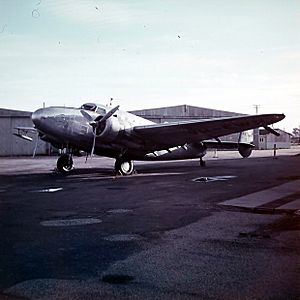

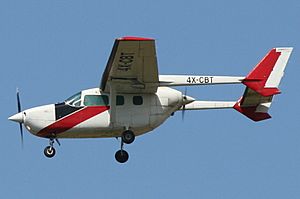

In 1891, Louis Gathmann suggested shooting liquid carbon dioxide into rain clouds to cause them to rain. During the 1930s, the Bergeron–Findeisen process theorized that supercooled water droplets present, while ice crystals are released into rain clouds, would cause rain. While researching aircraft icing, General Electric (GE)'s Vincent Schaefer and Irving Langmuir confirmed the theory. Schaefer discovered the principle of cloud seeding in July 1946 through a series of serendipitous events. Following ideas generated between him and Nobel laureate Langmuir while climbing Mt Washington in New Hampshire, Schaefer, Langmuir's research associate, created a way of experimenting with supercooled clouds using a deep freeze unit of potential agents to stimulate ice crystal growth, i.e., table salt, talcum powder, soils, dust, and various chemical agents with minor effect. Then one hot and humid July 14, 1946, he wanted to try a few experiments at GE's Schenectady Research Lab
He was dismayed to find that the deep freezer was not cold enough to produce a "cloud" using breath air. He decided to move the process along by adding a chunk of dry ice just to lower the temperature of his experimental chamber. To his astonishment, as soon as he breathed into the deep freezer, he noted a bluish haze, followed by an eye-popping display of millions of microscopic ice crystals, reflecting the strong light rays from the lamp illuminating a cross-section of the chamber. He instantly realized that he had discovered a way to change super-cooled water into ice crystals. The experiment was easily replicated, and he explored the temperature gradient to establish the −40 °C (−40 °F) limit for liquid water.
Within the month, Schaefer's colleague, the atmospheric scientist Dr. Bernard Vonnegut, was credited with discovering another method for "seeding" super-cooled cloud water. Vonnegut accomplished his discovery at the desk, looking up information in a basic chemistry text and then tinkering with silver and iodide chemicals to produce silver iodide. Together with Professor Henry Chessin, of SUNY Albany, a crystallographer, he co-authored a publication in Science and received a patent in 1975. Both methods were adopted for use in cloud seeding during 1946 while working for GE in the state of New York.
Schaefer's method altered a cloud's heat budget; Vonnegut's altered formative crystal structure, an ingenious property related to a good match in lattice constant between the two types of crystal. (The crystallography of ice later played a role in Vonnegut's brother Kurt Vonnegut's novel Cat's Cradle). The first attempt to modify natural clouds in the field through "cloud seeding" began during a flight that began in upstate New York on 13 November 1946. Schaefer was able to cause snow to fall near Mount Greylock in western Massachusetts, after he dumped six pounds (2.5 kg) of dry ice into the target cloud from a plane after a 60-mile (100 km) easterly chase from the Schenectady County Airport.
Dry ice and silver iodide agents are effective in changing the physical chemistry of super-cooled clouds, thus useful in augmentation of winter snowfall over mountains and under certain conditions, in lightning and hail suppression. While not a new technique, hygroscopic seeding for enhancement of rainfall in warm clouds is enjoying a revival, based on some positive indications from research in South Africa, Mexico, and elsewhere. The hygroscopic material most commonly used is table salt. It is postulated that hygroscopic seeding causes the droplet size spectrum in clouds to become more maritime (bigger drops) and less continental, stimulating rainfall through coalescence. From March 1967 until July 1972, the US military's Operation Popeye cloud-seeded silver iodide to extend the monsoon season over North Vietnam, specifically the Ho Chi Minh Trail. The operation resulted in the targeted areas seeing an extension of the monsoon period an average of 30 to 45 days. The 54th Weather Reconnaissance Squadron carried out the operation to "make mud, not war".
One private organization that offered, during the 1970s, to conduct weather modification (cloud seeding from the ground using silver iodide flares) was Irving P. Krick and Associates of Palm Springs, California. They were contracted by Oklahoma State University in 1972 to conduct a seeding project to increase warm cloud rainfall in the Lake Carl Blackwell watershed. That lake was, at that time (1972–73), the primary water supply for Stillwater, Oklahoma and was dangerously low. The project did not operate for a long enough time to show statistically any change from natural variations.
An attempt by the United States military to modify hurricanes in the Atlantic basin using cloud seeding in the 1960s was called Project Stormfury. Only a few hurricanes were tested with cloud seeding because of the strict rules set by the scientists of the project. It was unclear whether the project was successful. Hurricanes appeared to change slightly in structure, but only temporarily. The fear that cloud seeding could potentially change the course or power of hurricanes and negatively affect people in the storm's path stopped the project.
Two federal agencies have supported various weather modification research projects, which began in the early-1960s: The United States Bureau of Reclamation (Reclamation; Department of the Interior) and the National Oceanic and Atmospheric Administration (NOAA; Department of Commerce). Reclamation sponsored several cloud seeding research projects under the umbrella of Project Skywater from 1964 to 1988, and NOAA conducted the Atmospheric Modification Program from 1979 to 1993. The sponsored projects were carried out in several states and two countries (Thailand and Morocco), studying both winter and summer cloud seeding. From 1962 to 1988 Reclamation developed cloud seeding applied research to augment water supplies in the western US. The research focused on winter orographic seeding to enhance snowfall in the Rocky Mountains and Sierra Nevada, and precipitation in coast ranges of southern California. In California Reclamation partnered with the California Department of Water Resources (CDWR) to sponsor the Serra Cooperative Pilot Project (SCPP), based in Auburn CA, to conduct seeding experiments in the central Sierra. The University of Nevada and Desert Research Institute provided cloud physics, physical chemistry, and other field support. The High Plains Cooperative Pilot Project (HIPLEX), focused on convective cloud seeding to increase rainfall during the growing season in Montana, Kansas, and Texas from 1974 to 1979.
In 1979, the World Meteorological Organization, and other member-states led by the Government of Spain conducted a Precipitation Enhancement Project (PEP) in Spain, with inconclusive results due probably to location selection issues.
Reclamation sponsored research at several universities including Colorado State University, Universities of Wyoming, Washington, UCLA, Utah, Chicago, NYU, Montana, Colorado and research teams at Stanford, Meteorology Research Inc., and Penn State University, and South Dakota School of Mines and Technology, North Dakota, Texas A&M, Texas Tech, and Oklahoma. Cooperative efforts with state water resources agencies in California, Colorado, Montana, Kansas, Oklahoma, Texas, and Arizona assured that the applied research met state water management needs. The High Plains Cooperative Pilot Project also engaged in partnerships with NASA, Environment Canada, and the National Center for Atmospheric Research (NCAR). More recently, in cooperation with six western states, Reclamation sponsored a small cooperative research program called the Weather Damage Modification Program, from 2002 to 2006.
In the United States, funding for research has declined in the last two decades. However, the Bureau of Reclamation sponsored a six-state research program from 2002 to 2006, called the "Weather Damage Modification Program". A 2003 study by the United States National Academy of Sciences urges a national research program to clear up remaining questions about weather modification's efficacy and practice.
In Australia, the Commonwealth Scientific and Industrial Research Organisation (CSIRO) conducted major trials between 1947 and the early-1960s:
- 1947 – 1952: CSIRO scientists dropped dry ice into the tops of cumulus clouds. The method worked reliably with clouds that were very cold, producing rain that would not have otherwise fallen.
- 1953 – 1956: CSIRO carried out similar trials in South Australia, Queensland and other states. Experiments used both ground-based and airborne silver iodide generators.
- Late-1950s and early-1960s: Cloud seeding in the Snowy Mountains, on the Cape York Peninsula in Queensland, in the New England District of New South Wales, and in the Warragamba catchment area west of Sydney.
Only the trial conducted in the Snowy Mountains produced statistically significant rainfall increases over the entire experiment.
Hydro Tasmania (at the time still known as the Hydro Electric Commission) began experimenting with cloud-seeding over lake catchments in central Tasmania in the early 1960s in order to determine if their electricity-producing dams could be kept at high water levels through cloud seeding. Tasmania proved to be one place where cloud seeding was highly effective. Various trials were undertaken between 1964 and 2005, and again between 2009 and 2016, but none have taken place since then. Hydro Tasmania also undertook soil and water survey samples and found negligible trace elements of the materials used for cloud seeding (such as silver iodine), and determined it did not have a detrimental effect on the environment.
An Austrian study to use silver iodide seeding for hail prevention ran during 1981–2000, and the technique is still actively deployed there.
Images for kids
-
Beechcraft King Air C90 used for cloud seeding operations in UAE
-
Partenavia P.68 Hagelflieger - Germany
-
Cessna 441 Conquest II used to conduct cloud-seeding flights in the Australian state of Tasmania
See also
 In Spanish: Siembra de nubes para niños
In Spanish: Siembra de nubes para niños



